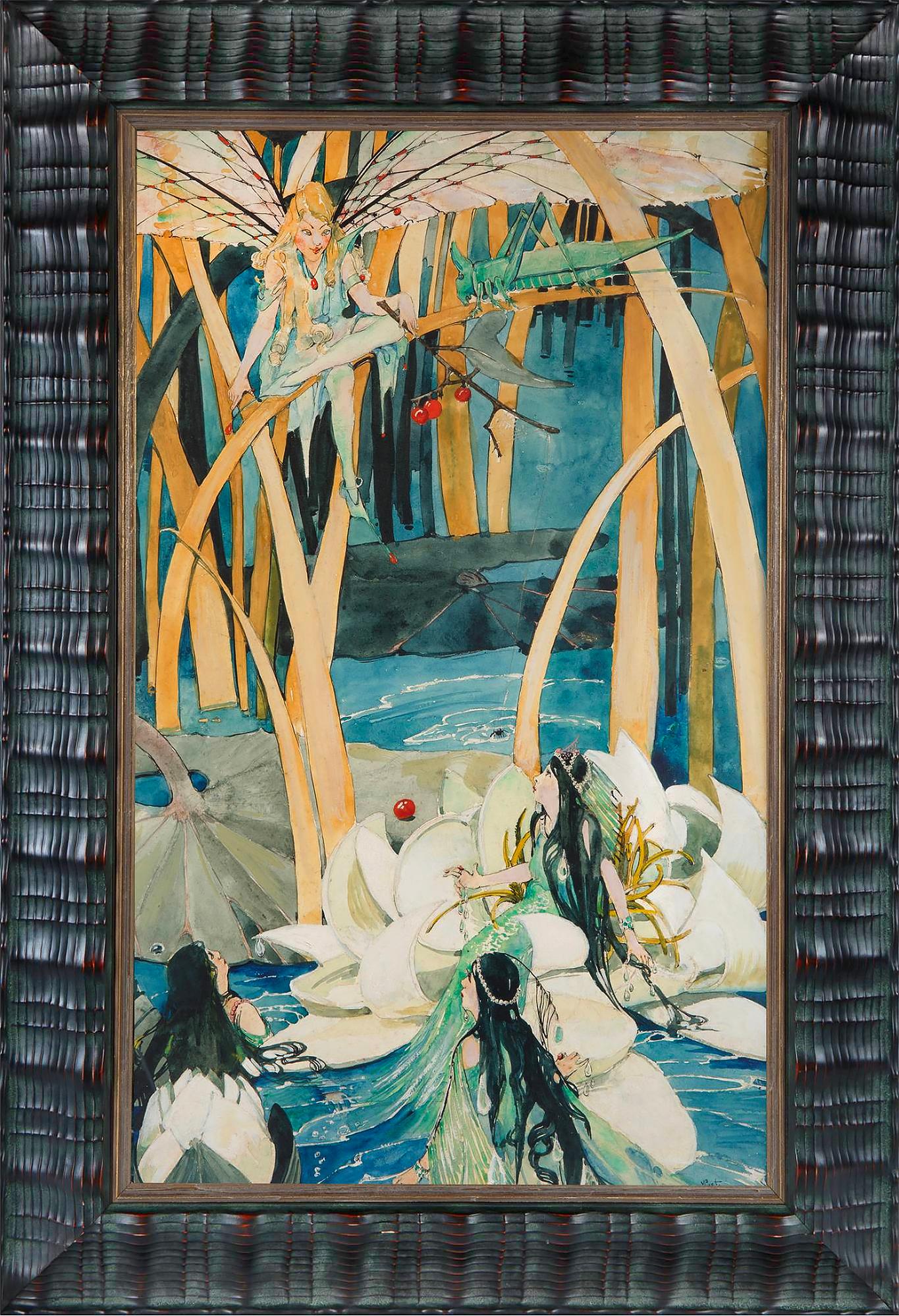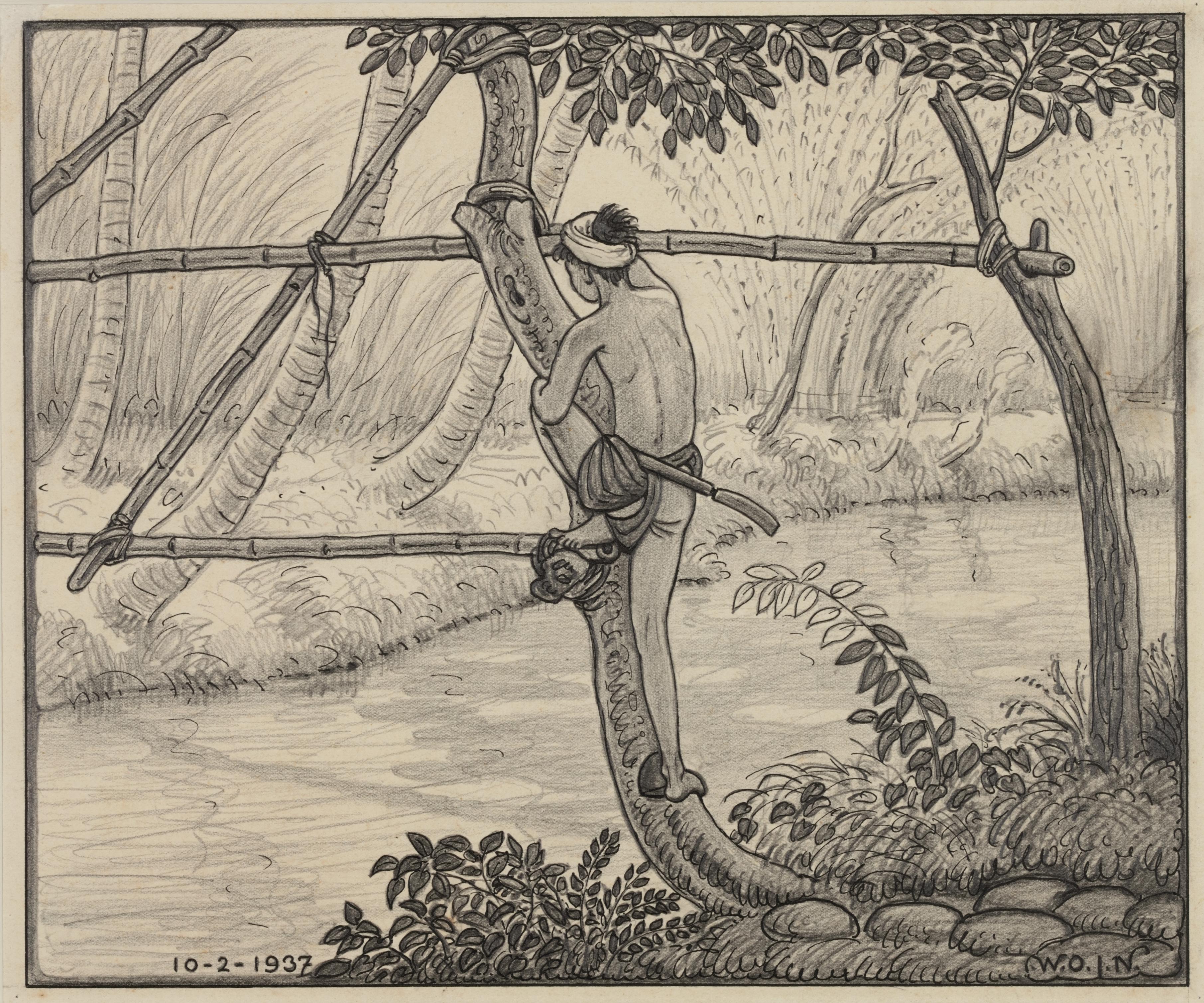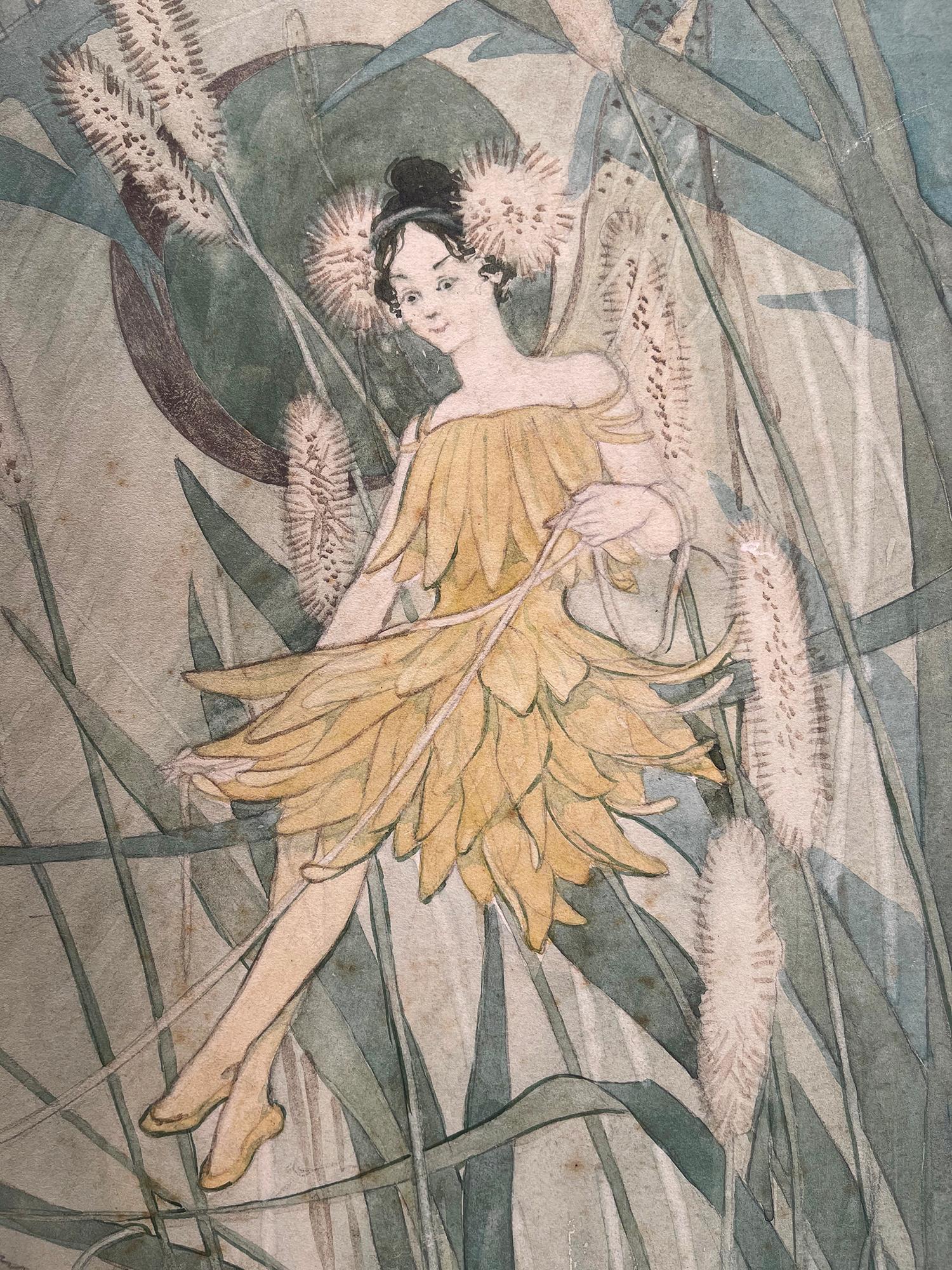Alphonse Mucha"Medieval Thoughts, Prague, " Alphonse Mucha, Czech Art Nouveau Illustrationcirca 1890
circa 1890
About the Item
- Creator:Alphonse Mucha (1860 - 1930, Czech)
- Creation Year:circa 1890
- Dimensions:Height: 16 in (40.64 cm)Width: 12 in (30.48 cm)
- Medium:
- Movement & Style:
- Period:
- Condition:Excellent.
- Gallery Location:New York, NY
- Reference Number:1stDibs: LU184129904512
Alphonse Mucha
Alphonse Mucha is acclaimed for his distinctly stylized and decorative Art Nouveau illustrated posters and prints — particularly those depicting beautiful French actress and famous artists’ muse Sarah Bernhardt. His work remains widely loved by everyone from bohemian students to serious collectors.
Mucha and his contemporaries treated femininity as the antidote to the impersonal, masculine world of the industrial revolution — it was to be celebrated and embraced. He fervently believed that art is a crucial, enjoyable benefit to humankind, and it should be accessible to as many people as possible.
Mucha showed an early talent for drawing. Rejected when he applied to the Academy of Fine Arts in Prague in 1878, he traveled to Vienna — two years later at the age of 19 — and found work painting theater backdrops. After a tragic fire that destroyed the theater that employed him, he returned home and began painting portraits. Count Eduard Khuen Belasi hired Mucha to paint a series of murals for his residence.
In 1885, the Count sent Mucha to the Munich Academy of Fine Arts — paying his tuition and living expenses. Mucha moved to Paris in 1888 to continue his studies, where he shared a studio with Paul Gauguin. There, he became enamored with the nude female form and allegorical studies. He enjoyed some financial success with magazine illustration work, which led to lucrative book illustration commissions. One of Mucha’s illustrations for the book Scenes and Episodes of German History received a medal of honor at the 1894 Paris Salon of Artists.
In 1894, Mucha began a six-year contract for the acclaimed stage actress Sarah Bernhardt, creating posters for her shows and tours. His first poster was an immediate sensation and cemented his fame in the Art Nouveau poster artist community.
Mucha designed some of the most famous posters of the era — a time when these works were key to the fabric of the cosmopolitan thoroughfare in the French capital. He created advertisements for JOB cigarette papers, Ruinart champagne, Lefèvre-Utile biscuits and Moët-Chandon champagne. Although Mucha is renowned for his posters, he spent the latter half of his life on decorative panel works and Czech nationalist artworks — many of them in the collection at the Mucha Museum in Prague.
Find original Alphonse Mucha nude prints, figurative prints, wall decorations and other art on 1stDibs.
- ShippingRetrieving quote...Ships From: New York, NY
- Return PolicyA return for this item may be initiated within 3 days of delivery.
- Five at the Rail, View of Racetrack and Crowd, Saratoga Springs, New YorkBy Anne DiggoryLocated in New York, NYAnne Diggory (b. 1951) Five at the Rail, Saratoga Springs Racecourse, New York, circa 1978 Watercolor on paper 4 3/4 x 6 inches Initialed lower right: Dig...Category
1970s Contemporary Landscape Drawings and Watercolors
MaterialsWatercolor, Paper
- "Sleigh Ride, Winter, " Fletcher Martin, Woodstock, Holiday Scene IllustrationBy Fletcher MartinLocated in New York, NYFletcher Martin (1904 - 1979) Sleigh Ride, Woodstock, New York circa 1955 Watercolor on paper 14 x 11 inches Signed lower right Provenance: James Cox Galler...Category
1950s American Realist Landscape Drawings and Watercolors
MaterialsPaper, Watercolor
- Out of the Sun (Under the Racetrack Grandstand), Saratoga Springs, Anne DiggoryBy Anne DiggoryLocated in New York, NYAnne Diggory (b. 1951) Out of the Sun (Under the Racetrack Grandstand), 1978 Watercolor on paper 7 x 10 inches Signed and dated lower left Provenance: Ac...Category
1970s Contemporary Landscape Drawings and Watercolors
MaterialsPaper, Watercolor, Pencil
- "Untitled, " Crash, Pop Art, Street Art Graffiti, Figure with ClockBy John Crash MatosLocated in New York, NYCrash Untitled, 1989 Signed and dated lower left Watercolor and ink on paper 30 x 20 1/2 inches A contemporary of Keith Haring and a modern-day master of this present day art form o...Category
1980s Street Art Figurative Paintings
MaterialsPaper, Ink, Watercolor
- "Pleased to See You, " Crash, Pop Art, Street Art GraffitiBy John Crash MatosLocated in New York, NYCrash Pleased to See You, 1989 Signed and dated lower left Watercolor and ink on paper 30 x 20 1/2 inches A contemporary of Keith Haring and a modern-day master of this present day ...Category
1980s Street Art Figurative Paintings
MaterialsInk, Watercolor, Paper
- "New York from the Ferry" John Marin, American Modernism Watercolor, CityscapeBy John MarinLocated in New York, NYJohn Marin New York from the Ferry, 1914 Signed and dated lower right Watercolor and graphite on paper 11 x 12 3/4 inches Provenance: An American Place, New York Kennedy Galleries, Inc., New York Christie's, New York, March 16, 1990, Lot 278 Private Collection (acquired from the above) Sotheby's New York, American Paintings, Drawings, & Sculpture, October 2, 2014, Lot 10 A major figure in early twentieth-century modernism, John Marin captured the colliding energies of the American urban scene and the vibrant contrasts of natural elements in the coastal landscape of Maine and other countryside locales. As one of the premier watercolorists of his era, Marin developed a light, spontaneous style ideally suited to conveying the freshness and flux of city and country experience -- his watercolors are often considered to match in strength those created by Winslow Homer in previous century. At the same time, Marin's sensitivity to mass, form, color, and line and their dynamic interchanges provided a precedent for the Abstract Expressionist movement of the late 1950s. Marin was born in Rutherford, New Jersey, to a family of European descent. After studying mechanical drawing and mathematics for half a year at the Stevens Institute of Technology in New York, Marin worked as a draftsman for several architects. It was not until he was almost thirty years old that he began to study art. He enrolled at the Pennsylvania Academy of the Fine Arts in Philadelphia from 1899 to 1901, and at the Art Students League in New York from 1901 to 1903, where his teachers were William Merritt Chase and Frank Vincent Dumond. While Marin was attending the League, the radical ideas of Arthur Wesley Dow were being disseminated and had an impact on the direction Marin would soon take in his art. Marin left for Europe in 1905. The next five years, which he spent abroad, were of tremendous importance to his career. He became a significant figure in the expatriate community in Paris, frequenting the Dôme, a café that served as a meeting place for artists and writers. While in Europe, Marin visited the Louvre and the Rijksmuseum in Amsterdam and, despite his claims that he had been indifferent to the Paris art world, he undoubtedly became aware of the art of Paul Cézanne and Henri Matisse. The works Marin created in Europe most strongly reflect the influence of James McNeill Whistler, especially the pastels he rendered in Venice. In the summer of 1909, Marin met Alfred Stieglitz in Paris. In February of the next year, Marin's work was shown along with that of Alfred Maurer at Stieglitz's gallery, 291. After returning to America in the following year, Marin became one of the most consistent members of Stieglitz's inner circle, showing at all three of his galleries -- 291, The Intimate Gallery, and An American Place. After 1910, Marin developed the routine that he would follow for the rest of his life, creating paintings, drawings, and prints in New York City and surrounding areas during the winter, and in the summer, traveling to the country, where he focused on the particular characteristics of the regions that he visited. He worked mainly in watercolor until 1928, when he began also to use oil. Marin never became purely abstract. He formulated a unique style melding influences of the art of the French Fauves, Cézanne, Matisse, and the French Cubists with a personal style of luminescent colors, agile brushwork, and a simultaneously delicate and strong handling. In city views, he used broken lines, a light touch, fluid color, and rhythmic compositions to convey what he described as the "great forces at work." He expressed the warring of the great and the small through relationships between masses. As he said, he sought to express the "pull forces" of the modern urban scene. Often portraying the new tall buildings of New York seen...Category
1910s American Modern Landscape Drawings and Watercolors
MaterialsPaper, Watercolor
- Fairies among the Lily Pads - Female Illustrator FantasyLocated in Miami, FLA turn-of-the-century fantasy illustration by female illustrator May Audubon Post features a charming fairy with expanded wings resting on Lilly s...Category
Early 1900s Art Nouveau Figurative Drawings and Watercolors
MaterialsPaper, Ink, Watercolor
- Statue of Vishnu Garuda, Bali, 1904Located in Amsterdam, NLStatue of Vishnu Garuda, Bali, 1904 Signed with initials Pencil and ink on paper, 21.4 x 21.3 cm Literature: Bruce W. Carpenter, W.O.J. Nieuwenkamp. First European Artist in Bali,...Category
Early 1900s Art Nouveau Landscape Drawings and Watercolors
MaterialsPencil, Paper, India Ink
- Beach of Kusambe, Bali 1937Located in Amsterdam, NLFour outrigger proa’s on the beach of Kusambe, Bali, 1937 Signed with initials, dated and described with location bottom left Pencil and ink on paper, 29.7 x 35 cm In ebonized frame with white mount WILLEM OTTO WIJNAND NIEUWENKAMP (1874-1950) Nieuwenkamp was born on July 27th 1874 in Amsterdam. His father owned sailing ships sailing to Indonesia and hearing the stories of the returning captains evoked in the young Nieuwenkamp an obsession for distant lands and adventure. After a failed attempt by his father to have his son make a career in his business, Nieuwenkamp attended the Academy for Decorative Art in Amsterdam. However, he left within one year to go his own way. He was an autodidact and a great experimenter with new techniques, particularly in the art of etching. Nieuwenkamp was a very focused man with the discipline of a scientist tempered by the sensitivity of an artist, a lust for adventure, a natural appreciation for ethnic arts and an enormous ambition to tread new paths. In 1898 he visited Indonesia for the first time and on his second visit in 1903-1904 he went on to Bali and became the first foreign artist to love Bali and the Balinese with a passion. Having secured agreements with several museums in the Netherlands to obtain Balinese art and objects for their collections, Nieuwenkamp immediately started to purchase and order a wide range of ethnographic art and objects from local artists and craftsmen. Through his drawings and books, he gave an excellent impression of Balinese art and culture at that time. Since 1854 Northern Bali was under Dutch...Category
1930s Art Nouveau Landscape Drawings and Watercolors
MaterialsIndia Ink, Paper, Pencil
- Borobudur, Java, Indonesia (1937)Located in Amsterdam, NLGraveyard with in the background the Borobudur, 1937 Signed with initials and dated bottom left Pencil and ink on paper, 33 x 29 cm In ebonized frame with white mount Literature: ...Category
1930s Art Nouveau Landscape Drawings and Watercolors
MaterialsPaper, Ink, Graphite
- Wobbly bridge, Tabanan, Bali, 1937Located in Amsterdam, NLWobbly bridge, Tabanan, Bali, 1937 Signed with initials bottom right and dated, bottom left Pencil and ink on paper, 22 x 26.3 cm In ebonized frame with white mount Willem Otto Wi...Category
1930s Art Nouveau Landscape Drawings and Watercolors
MaterialsIndia Ink, Paper, Pencil
- Fairy in the Pussy Willows with Baby and Spider Web Fantasy Children's BookLocated in Miami, FLThis work is presented more as a concept piece since it's condition is destresed. Illustrator Hazel Frazee was a Female Illustrator in the first quarter of the 20th century for child...Category
1920s Art Nouveau Landscape Drawings and Watercolors
MaterialsPencil, Watercolor






